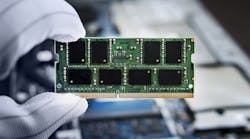Micron Doubles Down on Cuts to Memory Chip Production
Micron Technology in March said it would reduce its DRAM and NAND production in 2019 as demand dropped off for short-term memory and long-term storage used in smartphones, data centers and personal computers, watering down the selling price of its products and eroding its profits. But the company, the No.4 player in the global chip industry, acknowledged last week that it needed to be more aggressive.
The company said it still planned to cut DRAM manufacturing by 5% to balance out the supply and demand of the short-term memory chips, which is what determines their average selling price. In March, Micron said it would also curtail NAND production by 5%. But Sanjay Mehrotra, Micron's chief executive, said on a conference call last week it would slash NAND production by another 5%—a total of 10% in 2019.
Micron said it would reduce its planned capital spending by $1.5 billion, bringing its total to about $9 billion in 2019. The company has struggled to manage the current oversupply of memory chips, driving down average prices for DRAM and NAND. Many of the company's largest customers are trying to get through surplus inventory they amassed over the last year during a global shortage of DRAM and NAND products.
The current oversupply in the NAND market is stems from accelerated supply growth driven by the semiconductor industry's shift to 3D NAND, the company said. "We continue to target our bit shipments to be close to the industry demand growth rate," said Mehrotra, who was hired as chief executive officer in 2016. "We are optimistic that the overall NAND market will start to stabilize in the second half of [2019]."
The cutbacks come as trade tensions between the United States and China destabilize the semiconductor industry. The conflict has caused uncertainty that major players in the chip business blame in part for hampering sales. And as Washington has stepped up its assault on China’s emerging technology industry, Beijing has also doubled down on its drive for self-sufficiency in chips, including DRAM and NAND.
Micron, the third largest producer of memory chips in the world, said the cuts would start to reduce the global memory supply before the end of the year. Other producers of DRAM and NAND, including Samsung and Toshiba, are also scrambling to curb capital spending as demand declines. Micron said it would keep tightening its belt: deeper cuts to the company's capital spending are coming in 2020, Mehrotra said.
Micron has also been buffeted by the ban on supplying chips to Huawei, its largest customer last year. The sanctions slapped on Huawei have cost it around $200 million in overall sales. However, the company said last week it had resumed some shipments of memory chips to Huawei based on its interpretation of the Trump administration's restrictions, which may be taken off the table as part of trade talks with China.
The company has been grappling with many other issues over the last year. Customers are reducing orders for chips used in smartphones, while shortages of computer chips from Intel have dampened demand in the personal computer space. Major cloud vendors, including Amazon, Microsoft and Google, have slashed spending on memory and other chips used in data centers after building up inventory in 2018.
The company's sales in the third quarter of 2019 slipped 39% over the last year and 18% over the last quarter to roughly $4.8 billion, according to chief financial officer David Zinsner. Gross margins plunged from 50% in the second quarter to 39% in the third quarter due to ongoing DRAM and NAND price declines, he added. Micron's inventory increased $500 million to $4.9 billion at the end of the third quarter.
Micron reported $3 billion in DRAM revenue. Sales of the short-term memory chips slipped 45% over the last year and 19% over the last quarter as DRAM prices plunged 20%. Micron's NAND sales dropped 18% versus the second quarter as ASPs decreased around 15% over the last three months. Shipments of NAND products declined in the mid-single-digit percent range in the third quarter of 2019, the company said.
Things could get worse before they get better. DRAM ASPs are projected to fall further in the current quarter, according to DRAMeXchange, a division of market researcher Trendforce. Industry analysts have also cast doubt on the ability of overall NAND ASPs to rebound. “While we continue to believe that the industry is structurally stronger, the confluence of events that impacted this year was unprecedented,” Mehrotra said.
"With the economic and trade challenges facing the industry, the near term continues to be uncertain," Mehrotra said. Micron sees stronger demand for memory chips in the second half of the year compared to the first half as prices improve and customers building data centers burn through surplus inventory. Computer chip shortages in the personal computer market have started to improve last quarter, according to Micron.
But the company is still far from safe harbor. The company's are projected to be between $4.3 billion to $4.7 billion in the fourth quarter of 2019, down 88% to 97% compared to the fourth quarter of 2018. DRAM demand growth in 2019 is estimated at 15% with the global supply of memory chips growing 15% to 20%, Micron said. NAND demand should increase in the mid-30% range in 2019, the company added.
Despite the short-term supply challenges and uncertainty caused by trade tensions, Mehrotra said Micron is in a stronger position than ever. He still believes that the company's broader customer base can better protect it from market fluctuations. He said last month that Micron is in the "early innings of growth" due to the increased demand for memory used in cars, factories and Internet of Things devices.

